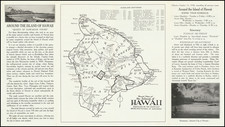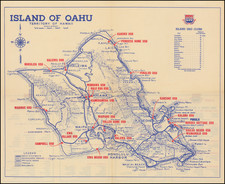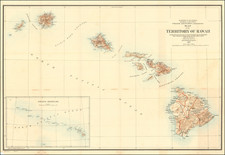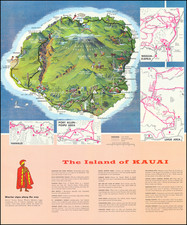Hawaiiana Bird's-Eye View Rarity.
Charming and very rare bird's-eye view of Nuuanu Valley (here "Nuanu Valley"), looking northwest from the top of a newly-built church at Beritania Street in Honolulu.
Aside from Paul Emmert's set of six views of Honolulu, Reps (Views & Viewmakers) records only five Hawaiian bird's eye views, comprising a set produced by George H. Burgess in 1857, with the present image being one of the five. This is perhaps a bit misleading, as Reps does not include the engraved views of the Lahainaluna Press in his list (as at the time located outside of the United States), but the fact that the totality of American bird's-eye views of Hawaii consists of just two sets of views (Emmert's and Burgess's) should underscore the extreme scarcity of Hawaiian bird's-eye views in general. Reps locates only two examples of the view, both in Hawaiian institutions (Bishops Museum and Hawaii State Library).
In comparing Burgess's views to Emmert's, Forbes says "In 1857 Emmert's lithographs were surpassed in quality, accuracy, and refinement of execution by the work of George H. Burgess". On this matter, our minds are not as settled as Forbes's; while the Burgess views are fantastic, the Emmert set is a crowning achievement of American viewmaking.
The complete set of Burgess views consists of the following titles:
Diamond Head, from Look-out
Diamond-Head from Honlu Beach
Nuanu Valley. From the New Church Beritania St.
Port of Honolulu
Ewa. From Honolulu
Nuanu Valley
The Nuʻuanu Pali has been a vital pass from ancient times to the present because it is a low, traversable section of the Koʻolau mountain range that connects the leeward side of the mountains, Honolulu to the windward side, Kailua and Kāneʻohe. The route drew settlers who formed villages in the area and populated Nuʻuanu Valley for a thousand years.
The Nuʻuanu Pali was the site of the Battle of Nuʻuanu, one of the bloodiest battles in Hawaiian history, in which Kamehameha I conquered the island of Oʻahu, bringing it under his rule. In 1795 Kamehameha I sailed from his home island of Hawaiʻi with an army of 10,000 warriors, including a handful of non-Hawaiian foreigners. After conquering the islands of Maui and Molokaʻi, he moved on to Oʻahu. The pivotal battle for the island occurred in Nuʻuanu Valley, where the defenders of Oʻahu, led by Kalanikūpule, were driven back up into the valley where they were trapped above the cliff. Kamehamehaʻs warriors forced Maui Chief Kalanikupule's men to their deaths off of the cliff. Roughly 400 warriors died in this battle. After this battle, Kapanui recited a Hawaiian chant as a sign of respect to those who have died there.
In 1845 the first road was built over the Nuʻuanu Pali, to connect Windward Oʻahu with Honolulu.
Two large stones near the back of Nuʻuanu Valley, Hapuʻu and Ka-lae-hau-ola, were said to represent a pair of goddesses who were guardians of the passage down the pali. Travellers would leave offerings of flowers or kapa (bark cloth) to ensure a safe trip, and parents buried the umbilical cords of newborns under the stones as a protection against evil.
According to legend, the pass is inhabited by a moʻo wahine, a lizard who takes the form of a beautiful woman and leads male travelers to their deaths off the cliff, similar to a western poltergeist or mermaid.
Hawaiian folklore holds that people should never carry pork over Nuʻuanu Pali, especially at night. Pele, the volcano goddess, was responsible for preventing passage due to her contest with Kamapua'a, a half human, half hog god, and would not allow him (in the form of pork) to trespass on her side of the island.
Rarity
The view is extremely rare on the market. Reps located only 2 examples (Hawaii State Library and Bishop's Museum).











![Oahu [Hawaiian Islands 1:25,000]](https://storage.googleapis.com/raremaps/img/small/96167.jpg)

![[Waikiki] Waikiki Photo-Guide Map](https://storage.googleapis.com/raremaps/img/small/87465.jpg)
